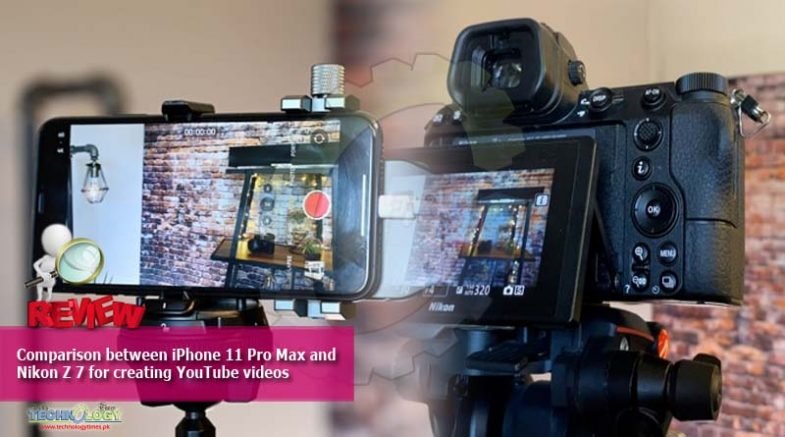Apple’s latest iPhones are equipped with some great cameras, but when it comes YouTube video creation, and other video shooting requires dedicated camera such as the Nikon Z 7.
 Nikon Z 7 Mirror less Digital Camera has a far higher megapixel count, when it comes to shooting video things get much more alike. Each video was shot in 4K at 24 frames per second our standard for video production.
Nikon Z 7 Mirror less Digital Camera has a far higher megapixel count, when it comes to shooting video things get much more alike. Each video was shot in 4K at 24 frames per second our standard for video production.
The video quality from each is very similar. Video cropped in the Nikon does have better detail but at full resolution, it is hard to tell the difference.
There are clear ways that the Nikon wins out. If you go to shoot photos as well as video, the Nikon has a major advantage. In this case, the Nikon Z 7 has a 45.7MP sensor compared to the iPhone’s 12MP. Nikon’s sensor is also a full-frame sensor measuring 36 by 24mm whereas the iPhone’s is just around 6mm squared.
With a dedicated camera, there is also a huge array of interchangeable lenses, larger lighting kits, external monitors such as the Atmos Ninja for external recording and viewing footage, no reliance on your phones internal storage, and in some cases in-body stabilizers.
When it comes to pro video, some form of dedicated camera is needed. An iPhone can shoot great video but if it comes to commercial projects, you need the flexibility and input/output options that a professional camera can offer.
The Nikon has more detail in the image, less grain, and more separation between the subject and the background.
If you’re shooting primarily on an iPhone there are a few ways it can succeed more than a dedicated camera. An iPhone is inherently more portable than a camera. Even mirror less cameras such as the Nikon Z 7 which are much slimmed down from a DSLR are larger than an iPhone. For true portability, it is hard to beat an iPhone. An iPhone is superbly thin and only weighs 226 grams total. The Nikon is larger, thicker, and weighs 585 grams for the body alone.
The iPhone also already has stabilization built-in and an external gimbal adds additional stabilization for not much cost. A gimbal for a camera is much more.
You can also directly rely on cloud storage with an iPhone be it the Photos app, iCloud Drive, Dropbox, Google Drive, and similar. You still need to transfer it to a different device with a camera. The iPhone even allows you to edit and share video right from the device itself.
The wealth of third-party apps that add different effects, high frame rate slow-motion video capture, and other video time-based effects is also of great advantage to iPhone video graphers. We’ll be talking about examples soon enough.
Clearly, there are benefits of going with each of the different platforms. It is primarily going to depend on what you plan to shoot which device is best, but it is hard to beat out the convenience of the iPhone. The Nikon is going to do better for pro video, low light situations, and fast action. The iPhone is great as a portable shooter you can carry in your pocket.
At the same time, cameras have come a long way. The new mirror less designs are more compact, offer stabilization for handheld shooting, and are far higher resolution. Not to mention the array of lenses and other accessories to boost the camera further ahead.
The Nikon Z 7 Mirrorless Digital Camera retails for $3,399.95, but leading retailers are knocking $600 off the body only, with deals on kits and accessories as well. Meanwhile, those interested in the portable iPhone 11 Pro Max can find a variety of promotions and incentives from leading wireless carriers in our iPhone deals roundup.
